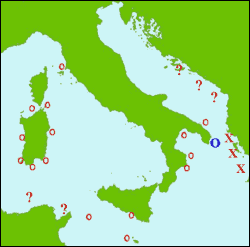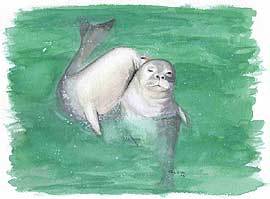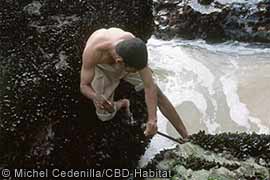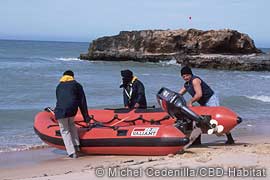

 |
||
 |
||
Vol. 6 (1): June 2003 |
Download this page
|
|
Bulgaria / Cyprus / Greece / Italy / Madeira / Mauritania and Western Sahara / Turkey
Italy
|
 |
Map: Areas characterised by sightings of single monk seals (red dots indicate sightings recorded between 1993-2002, blue dot indicates the present Apulia sighting), nearby Italian areas with known monk seal presence (red Xs) and with hypothetical monk seal presence (red question marks). Monk seal sightings information in Italy is gathered and analysed through a joint program of the Gruppo Foca Monaca and ICRAM. |
Sporadic sightings of monk seals around southern Italy and Sardinia may indicate seasonal movements from other areas – the Ionian Islands of Greece or the North African coast. Conceivably, they may also suggest that the resident monk seal population in Italy has not been entirely eradicated as previously feared. – Emanuele Coppola, Gruppo Foca Monaca.
As revealed in last November’s issue of TMG [see Sightings - and "accidents" - increase around Madeira, TMG 5 (2): November 2002], the Parque Natural da Madeira has launched a public awareness campaign to gather information on the monk seal’s apparent re-colonisation of the island, and also to advise people how to behave if they encounter a seal.
Sightings of seals around the main island have shown a marked increase in frequency of late, with over 30 observations being recorded last year. Researchers believe that, as the seal colony at the strictly-protected Desertas Islands Nature Reserve has recovered from near extinction in the 1980s, individual animals may be dispersing towards the main island in search of new habitat [see Madeira island observations, TMG 4(2): November 2001 and Are monk seals recolonising Madeira island? TMG 4(1): May 2001].
 |
|
|
Monk seals in the PNM brochure |
The increased sightings have posed something of a dilemma for conservationists, however, as incautious humans unused to seals have approached the animals in an attempt to pet or play with them. Some injuries were sustained as a result of these interactions, and although most members of the public took a cautious, commonsense approach when encountering a seal, the PNM felt it necessary to issue a brochure highlighting the potential risks [an English version has been lodged in the Monachus Library – see below]. At the same time, a sightings observation sheet was also produced. Hopefully, this will encourage members of the public to continue reporting their observations, thereby helping PNM researchers to gain a better understanding of seal’s reappearance around Madeira. – Rosa Pires, Parque Natural da Madeira.
In the Monachus Library:
Parque Natural da Madeira. 2003. Help us to help the monk seal. English brochure and sighting register: 1–2.
Wardens in the strictly-protected Desertas Islands Nature Reserve detected two new monk seal pups on 2 May. They are no more than a month old. – Rosa Pires, Parque Natural da Madeira.
Six months have passed since we all saw on television how the oil tanker “Prestige” was sinking in the Atlantic off the Galician coasts, a Spanish region famous for its sea and excellent shellfish.
The first consequences of the disaster were obvious: kilometres and kilometres of beaches and coastline completely flooded with oil, causing the deaths of thousands of marine birds, and forcing the closure of the area’s lucrative fishing and shellfish grounds. One of the most affected marine resources were goose barnacles, suddenly covered by a thick layer of fuel-oil. Almost overnight, the steep prices already commanded in the marketplace for this crustacean rose astronomically.
Sellers looked for alternative sources to feed demand, including Saharan coasts.
 |
|
|
Goose barnacle picker on the ‘Coast of Seals’. |
Although seemingly incredible, this is how the “Prestige” disaster has even had a tangible impact on the surroundings of the Cabo Blanco monk seal colony.
During these last months, the CBD-Habitat surveillance patrol has had to deal with waves of goose barnacle pickers – many of them new to the trade, but motivated by persistent good prices – and to exert great effort in order to divert them away from monk seal breeding caves.
As explained in last November’s TMG [Conservation actions on the Cabo Blanco peninsula – a new approach, TMG 5 (2): November 2002] and in this issue’s In Focus article, the pickers descend from cliff-tops to anywhere goose barnacles can be harvested, including caves.
Land-based surveillance is therefore proving essential to prevent disturbance and to ensure peace and safety for the Cabo Blanco monk seal colony. – Pablo Fernández de Larrinoa & Hamdi M’Barek, CBD-Habitat.
In may 2001, as a consequence of a no-fishing agreement with local artisanal fishermen, [Conservation actions on the Cabo Blanco peninsula – a new approach, TMG 5 (2): November 2002] CBD-Habitat technicians were able to mark as protected, six kilometres of coast incorporating the seal colony’s breeding caves. Surveillance teams immediately began to patrol the area.
 |
|
|
Preparing for a surveillance patrol within the red-flagged protection zone. |
Since then, surveillance of the marine area has been performed both from land and on sea. On land, surveillance relies on observations with binoculars. When a pirogue is observed placing nets within the marked area, for example, the vessel or the harbour where it originated will be identified. Technicians will then go to the harbour and ask the fishermen to remove the fishing gear as soon as possible. After some discussion and explanation, fishermen will normally agree to comply, largely because of the cordial atmosphere that exists between them and the CBD-Habitat technicians. Such violations of the protected zone were more common when the area was first marked, and before word spread among of the fishermen of its establishment.
Since December last year, surveillance is also being conducted on the sea, using a new inflatable vessel. This boat allows wardens to monitor the surroundings of the breeding caves, but more importantly, to make their presence known to fishermen, thereby deterring them from laying fishing gear in the area. Positive results have come quickly, with even the most crafty fishermen being deterred by the presence of the surveillance boat.
Infractions during the summer season – when fishing activity normally peaks because of better sea conditions – are also expected to diminish this year. – Mulay Haya and Pablo Fernández de Larrinoa, CBD-Habitat.
During May, work is expected to be completed on upgrading monk seal rehabilitation facilities at the Mauritanian Institute for Oceanographic and Fisheries Research (IMROP, formerly CNROP) in the city of Cansado.
Alteration works are being performed jointly by CBD-Habitat and the IMROP staff with funds from the Spanish Cooperation Agency and the Spanish Ministry of Environment.
The facilities are being optimised to rehabilitate pups rescued from the nearby monk seal colony at Cabo Blanco. When still only a few weeks old, the pups are sometimes at severe risk from storm surges, that can enter the breeding cave and sweep them out to sea.
So far, 7 pups have been rehabilitated at these facilities (once, four at the same time), of which 6 have been reintroduced to the wild, and 1 has died.
Although originally constructed as an aquarium rather than a rescue centre, the facilities have been progressively adapted and improved to meet monk seal rehabilitation needs since the Spanish team first began to work at Cabo Blanco and the need for rehabilitation became apparent.
Following alteration works, the facilities are now able to house seals in improved conditions during their rehabilitation at the centre. – Hamdi M’barek & Miguel Angel Cedenilla, CBD-Habitat.
Between June 2002 and the end of May 2003, 25 newborn pups were detected in the Cabo Blanco colony. Most births took place during the September-December period, with October being the month with the highest number of pups. Of these 25 newborn monk seals, 12 have died, resulting in a 48% pup mortality rate for this period.
During the period from October to January, most of the pups born subsequently died, a phenomenon that coincides with seasonal stormy weather conditions at sea.
All the pups that died did so before reaching the first two weeks of life. 75% of them died in the first three days of life, while none of the remainder survived to 10 days. Therefore, the critical period for pup survival remains two weeks.
Following the 1997 mass die-off, productivity seems to remain stable at around 25 annual births. Also, mortality rates remain stable around 50%, a too high a rate for an endangered species. – Miguel Angel Cedenilla & Mulay Haya, CBD-Habitat.
Mediterranean News continues with Turkey...
Copyright © 2003 The Monachus Guardian. All Rights Reserved |